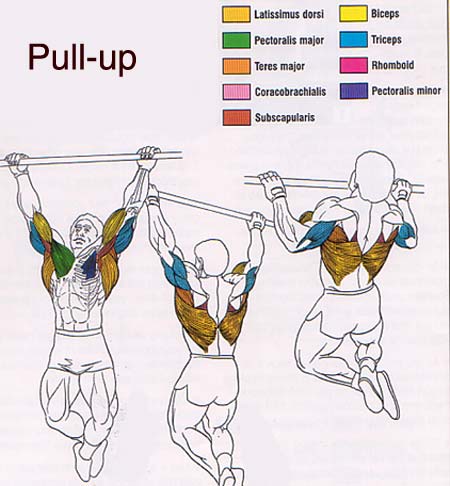Just read this research article in this month's Journal of Strength & Conditioning Research. Practitioners have said this for a long time now but as I always say, it's nice when researchers confirm what we have found in our 'labs'.
Relationship of 1 repetition maximum lat-pull to pull-up and lat-pull repetitions in elite collegiate women swimmers.
Halet KA, Mayhew JL, Murphy C, Fanthorpe J.
Human Performance Laboratory, Truman State University, Kirksville, Missouri 63501, USA.
The purposes of this study were to determine the relationships among pull-ups, lat-pull repetitions, and 1 repetition maximum (1RM) lat-pull in elite women swimmers and to assess the effect of various anthropometric dimensions on each exercise. Women members (n = 28) of an elite National Collegiate Athletic Association (NCAA) Division II swim team were measured for their ability to perform a maximum number of free-hanging pull-ups, 1RM lat-pull, and lat-pull repetitions at 80% of 1RM. Anthropometric dimensions included selected arm lengths, percent body fat (%fat), and lean body mass (LBM) estimated from skinfold measurements. The correlations of 1RM lat-pull with body mass (r = 0.38, p = 0.04) and LBM (r = 0.41, p = 0.03) were significant, whereas that with %fat (r = 0.13, p = 0.49) was not. The same variables had a significant negative pattern with pull-ups (r = -0.48, -0.43, -0.32, respectively). Pull-ups were moderately correlated with 1RM lat-pull (r = 0.34, p = 0.08) but not with lat-pull repetitions (r = 0.07, p = 0.73). The product of pull-ups times body mass (PU x BM) was a better predictor of 1RM lat-pull (r = 0.86, standard errors of estimate [SEEs] = 4.4 kg) than either measurement alone. The addition of %fat to PU x BM in a stepwise regression analysis raised the correlation (R = 0.90) and reduced the SEE (3.9 kg) only slightly. Addition of arm or forearm lengths failed to increase the multiple R significantly. These results confirmed that the seemingly analogous exercises of pull-ups and lat-pulls were not highly related and should not be substituted for one another in a training regimen.
Human Performance Laboratory, Truman State University, Kirksville, Missouri 63501, USA.
The purposes of this study were to determine the relationships among pull-ups, lat-pull repetitions, and 1 repetition maximum (1RM) lat-pull in elite women swimmers and to assess the effect of various anthropometric dimensions on each exercise. Women members (n = 28) of an elite National Collegiate Athletic Association (NCAA) Division II swim team were measured for their ability to perform a maximum number of free-hanging pull-ups, 1RM lat-pull, and lat-pull repetitions at 80% of 1RM. Anthropometric dimensions included selected arm lengths, percent body fat (%fat), and lean body mass (LBM) estimated from skinfold measurements. The correlations of 1RM lat-pull with body mass (r = 0.38, p = 0.04) and LBM (r = 0.41, p = 0.03) were significant, whereas that with %fat (r = 0.13, p = 0.49) was not. The same variables had a significant negative pattern with pull-ups (r = -0.48, -0.43, -0.32, respectively). Pull-ups were moderately correlated with 1RM lat-pull (r = 0.34, p = 0.08) but not with lat-pull repetitions (r = 0.07, p = 0.73). The product of pull-ups times body mass (PU x BM) was a better predictor of 1RM lat-pull (r = 0.86, standard errors of estimate [SEEs] = 4.4 kg) than either measurement alone. The addition of %fat to PU x BM in a stepwise regression analysis raised the correlation (R = 0.90) and reduced the SEE (3.9 kg) only slightly. Addition of arm or forearm lengths failed to increase the multiple R significantly. These results confirmed that the seemingly analogous exercises of pull-ups and lat-pulls were not highly related and should not be substituted for one another in a training regimen.
The correlations showed that the lat pulldown and the pull-up were not very closely related. In addition, several factors seem to come into play when testing females on pull-up performance. The researchers stated that body mass was the main factor in the inability to perform pull-ups. Since the lat pulldown is in fact a different exercise than the pull-up, the researchers recommended not trying to substitute one of another in training. We can now see that moving to the lat pulldown machine in hopes of improving your pull-up ability is not a great strategy.







